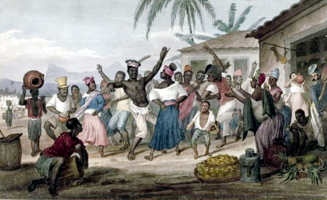
|
The Society of Folk Dance Historians (SFDH)
Brazilian Dance
[
Home |
About |
Encyclopedia | CLICK AN IMAGE TO ENLARGE |

|
BACKGROUND
Brazil is a land of many popular dances that contain the elements of African, Portuguese, and European dance forms. Capoeira, Carimbo, Forró, Jongo, and Samba are some of the famous dances of Brazil. Here is an account of the origin and evolution of these and other dances.
Brazil was a Portuguese colony during the period 1500 to 1822. Portuguese rulers mainly brought African slaves from Angola to Brazil. When the slaves reached Brazil, they were converted to Christianity and prevented from worshiping their traditional gods by the Portuguese. They continued to carry out religious practices in the guise of parties.
SAMBA
 Samba is a Brazilian musical genre and dance style, with its roots in Africa. It is what immediately comes to mind at the very mention of Brazilian dance. The modern Samba emerged at the beginning of the 20th century in Rio de Janeiro. The term samba encompassed many different rhythms, tunes, drumming, and dances of various periods and areas of the Brazilian territory. In the indigenous language, samba means a circle dance for celebrations such as Catholic festivals, Amerindian, or Afro-Brazilian religious ceremonies. Some believe that samba was derived from the word semba, which signifies a naval bump in Kimbundu, a Bantu language, and symbolizes the invitation to dance from a man to a woman. Semba is also an infinitive of kusamba, which means to pray, or to appeal for the favor of the gods or ancestors by singing and dancing. So, the dance was an indispensable part of the religious ceremonies.
Samba is a Brazilian musical genre and dance style, with its roots in Africa. It is what immediately comes to mind at the very mention of Brazilian dance. The modern Samba emerged at the beginning of the 20th century in Rio de Janeiro. The term samba encompassed many different rhythms, tunes, drumming, and dances of various periods and areas of the Brazilian territory. In the indigenous language, samba means a circle dance for celebrations such as Catholic festivals, Amerindian, or Afro-Brazilian religious ceremonies. Some believe that samba was derived from the word semba, which signifies a naval bump in Kimbundu, a Bantu language, and symbolizes the invitation to dance from a man to a woman. Semba is also an infinitive of kusamba, which means to pray, or to appeal for the favor of the gods or ancestors by singing and dancing. So, the dance was an indispensable part of the religious ceremonies.
The factor that frequently draws the attention of most people to the rhythm is the unusually-accented (syncopated) beat. The absent beat is the strongest characteristic of Samba, promoting the listener to dance to fill the gap with his/her body movements. This syncopated rhythm is also an indication of Black resistance against cultural assimilation. The Samba de Roda in particular was considered an expression of freedom and identity of the underprivileged and became a means of Liberation.
SAMBA DE RODA
Samba de Roda (dance circle) is the main root of the Samba Carioca, the type of Samba that is played and danced in Rio de Janeiro. It appeared in the state of Bahia, more specifically in the region of Recûoncavo, during the 17th century.
All participants, including beginners, are invited to join the dance and observe as well as imitate. Usually, only the women dance, with one solo dancer after another, surrounded by others dancing in a circle and clapping their hands. The choreography is often spontaneous and is based on movements of the feet, legs, and hips. One of the most typical moves is the umbigada which has clear Bantu influence, where the dancer invites her successor into the circle's center. The Samba de Roda has significantly waned during the 20th century because of economic decline and increased poverty in the region. The effects of mass media and competition from popular modern music have also devalued this tradition among the younger generation. Finally, the weakening of the Samba de Roda was heightened through the aging of practitioners and demise of those who made the musical instruments.
Jongo is associated withe African culture in Brazil. The formation of Samba Carioca was heavily influenced by Jongo, that was brought to Brazil by Bantus. The Jongo most likely has its origins in the traditional Angolan guessing games, the Jinongonongo.
One essential characteristic of Jongo is the utilization of symbols that, aside from maintaining rhythm, possess a magical function, apparently evoking paranormal phenomenon. Among the more evident symbols one can cite are: the fire, with which the instruments are tuned; the drums, that are considered to be ancestors of the community; the circular form of the dance with a couple in the middle, which refers to fertility; and the rich metaphors used by the jongueiros (participants of the Jongo) in order to compose its main points and whose meaning is inaccessible to those not yet initiated.
These days, both men and women can participate in the Jongo, but this participation in its original form, was very restricted to the initiated or the more experienced members. This is related to the ethical and social norms commonly found in other traditional societies, such as the Amerindians. The basis is a respect and obedience towards the older individuals and the ancestral past. Historical research indicates that the Jongo possesses, within its Bantu origins, the need to create diverse communities, similar to secret societies and political-religious sects. These fraternities had an important role in the resistance to slavery, as a means of communication, organization, and even the purchase of slaves to liberate them.
The Jongo is still widely practiced today in various regions: Vale do Paraíba in the southeast region of Brazil, to the south of the state of Rio de Janeiro and to the north of São Paulo.
CAPOEIRA
Capoeira is another important Afro-Brazilian dance, and believed to have evolved from martial arts. It was also created in Brazil by African slaves, mainly from Angola. Some experts suggested that the word capoeira was derived from capao, which is a Portuguese word for "castrated rooster." The dancing style is also similar to a fight between two roosters. Or Capoeira could have gotten its name from the Bangu Kikongo word kipura, that describes the movement of a rooster while fighting. Though there are considerable differences of opinion regarding the origin of the dance and its name, the dance steps have close similarity with martial arts, with fighting movements like kicks, sweeps, punches, and elbow strikes. The participants usually form a circle than take turns in pairs in playing a musical instrument or singing or performing fighting acts in the center.
CARIMBO
Carimbo is a folk dance of the Para state in Brazil, in which African, Portuguese, and European influence can be noticed. Carimbo is the name of both the dance and the large drums that accompany it. It is a sensual dance, where the woman tries to cover the man with her skirt. Sometimes, the woman throws her handkerchief on the floor, which her male partner has to retrieve by using his mouth. With the influence or more modern rhythms, Carimbo contributed to the development of another dance form, Lambada. In Portuguese, "lambada" means "strong slap" or "hit." It may refer to the wave-like motion of a ship in Brazilian Portuguese. The dance is also characterized by wave-like body movements of the dancers and became popular throughout the world in the 1980s.
FORRÓ
Forró, derived from the word forrobodo, means "great party." it is one of the most popular dances of northeastern Brazil and can be danced to the rhythm of different musical genres. There is a lot of variation in the dancing style of Forró in different regions of Brazil. It is danced with partners performing many complex steps.
XOTE
Xote, a common type of Forró dancing, is a Brazilian music genre and dance for pairs or groups of four. It is the local equivalent of the Schottische. The word site is a corruption of the German word schottisch, meaning "Scottish." The Schottische was brought to Brazil in 1851, and was popular among the upper classes. Later, African slaves danced their own adaptations of the dance, adding their own influences, converting it into a dance that was more popular and well known. The Xote is a very versatile dance and has a number of local variations, such as, the southern version called Xote Gaúcho.
XAXADO
Xaxado is a popular dance and was often practiced to commemorate victory in battle; it is also practiced as a traditional dance by the local population as a whole. The name xaxado comes from the noise made by sandals as they strike the sand during the dance.
CIRANDA
Ciranda is a type of dance and music from Pernambuco. The fishermen's wives sang and danced, hoping their husbands would reach the sea. It is characterized by the formation of a large circle, usually on the beaches and parks, where members dance to the sound of slow and repeated music. There are three main steps which feature: an onda – the wave, o sacudidinho – the little shake, and o machucadinho – the little crushing step.
There is also no limit to the number of people who can participate in the dance. Generally, the dance begins with a small circle of just a few people, which steadily grows as other people begin to join in. These "latecomers," without any kind of special ceremony, merely insert themselves into the ring by separating and holding the hands of the original participants. Should a participant need to leave the circle through tiredness, or any other motive, then he or she leaves in exactly the same way that he or she entered. If and when the circle of dancers becomes too large, and the movement becomes to restricted, then another smaller circle is created in the center of the original circle. The simple objective of this dance is – happiness for everyone!
MACULELÊ
Maculelê is an Afro-Brazilian dance where people gather in a circle. Each person brandishes a pair of long sticks, called grimas. As the Maculelê rhythm plays, the people in the circle begin rhythmically striking the sticks together. The leader sings, and the people in the circle respond by singing the chorus of the songs. When the leader gives the signal to begin playing Maculelê, two people enter the circle and begin striking their own and each other's sticks together. On the first three beats, they strike their own sticks together, making expressive and athletic dance movements, and on each fourth beat, they strike each other's right-hand sticks together. This makes for a dance that looks like "mock stick combat." (Also, traditionally in Maculelê, the players wear dried grass skirts.)
DOCUMENT
- Brazil, a country.
Used with permission of the author.
A compilation of articles from the Internet
printed in Folk Dance Scene, September 2016.
This page © 2018 by Ron Houston.
Please do not copy any part of this page without including this copyright notice.
Please do not copy small portions out of context.
Please do not copy large portions without permission from Ron Houston.
